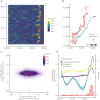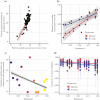Baboon travel progressions as a "social spandrel" in collective animal behaviour
- PMID: 40568525
- PMCID: PMC12188440
- DOI: 10.1093/beheco/araf022
Baboon travel progressions as a "social spandrel" in collective animal behaviour
Abstract
How individuals in a group move relative to one another can influence both their survival and fitness. Spatial positioning has been well studied in baboons (Papio spp.), which travel collectively in line formations or "progressions." Early studies of baboon progressions presented contradictory findings on the progressions' order - some reporting random positioning of individuals, while others reporting non-random positioning, thought to protect more vulnerable group-members. Here, we revisit this topic and use high-resolution GPS tracking data to study travel progressions in a group of chacma baboon (Papio ursinus) on Cape Peninsula, South Africa. We identify 78 progressions over 36 d and find that progression orders are not random. We test four non-exclusive hypotheses to explain progression orders: vulnerable individuals position themselves in the middle (risk hypothesis), subordinate individuals position themselves at the front to gain better access to resources (competition hypothesis), dominant individuals assume leading positions (group decision-making hypothesis), or progression order is an emergent outcome of underlying social bonds (social spandrel hypothesis). We find no evidence that progression orders are adaptive responses to minimize an individuals' risk, maximize their resource acquisition, or are the result of decision-makers leading the group. Instead, we find that individuals' positions are predicted by pairwise affiliations, resulting in consistency in order, with more dominant individuals occupying central positions in progressions. This non-random structuring of individuals during progressions can be considered a side-effect or outcome of underlying social forces acting among individuals, providing an example of a "social spandrel" in collective animal behaviour.
Keywords: chacma baboons; collective behaviour; group progressions; social dominance; spatial positioning.
© The Author(s) 2025. Published by Oxford University Press on behalf of the International Society for Behavioral Ecology.
Conflict of interest statement
We declare we have no competing interests.
Figures



Similar articles
-
Psychological interventions for adults who have sexually offended or are at risk of offending.Cochrane Database Syst Rev. 2012 Dec 12;12(12):CD007507. doi: 10.1002/14651858.CD007507.pub2. Cochrane Database Syst Rev. 2012. PMID: 23235646 Free PMC article.
-
Signs and symptoms to determine if a patient presenting in primary care or hospital outpatient settings has COVID-19.Cochrane Database Syst Rev. 2022 May 20;5(5):CD013665. doi: 10.1002/14651858.CD013665.pub3. Cochrane Database Syst Rev. 2022. PMID: 35593186 Free PMC article.
-
Positioning for acute respiratory distress in hospitalised infants and children.Cochrane Database Syst Rev. 2022 Jun 6;6(6):CD003645. doi: 10.1002/14651858.CD003645.pub4. Cochrane Database Syst Rev. 2022. PMID: 35661343 Free PMC article.
-
Individual-level interventions to reduce personal exposure to outdoor air pollution and their effects on people with long-term respiratory conditions.Cochrane Database Syst Rev. 2021 Aug 9;8(8):CD013441. doi: 10.1002/14651858.CD013441.pub2. Cochrane Database Syst Rev. 2021. PMID: 34368949 Free PMC article.
-
Education support services for improving school engagement and academic performance of children and adolescents with a chronic health condition.Cochrane Database Syst Rev. 2023 Feb 8;2(2):CD011538. doi: 10.1002/14651858.CD011538.pub2. Cochrane Database Syst Rev. 2023. PMID: 36752365 Free PMC article.
References
-
- Albery GF et al. 2024. Expanding theory, methodology and empirical systems at the spatial–social interface. Philos Trans R Soc B Biol Sci. 379(1912):20220534. https://doi.org/ 10.1098/rstb.2022.0534 - DOI - PMC - PubMed
-
- Altmann SA. 1979. Baboon progressions: order or chaos? A study of one-dimensional group geometry. Anim Behav. 27:46–80. https://doi.org/ 10.1016/0003-3472(79)90128-3 - DOI
-
- Aplin LM, Farine DR, Mann RP, Sheldon BC.. 2014. Individual-level personality influences social foraging and collective behaviour in wild birds. Proc Biol Sci. 281(1789):20141016. https://doi.org/ 10.1098/rspb.2014.1016 - DOI - PMC - PubMed
-
- Barton RA. 1993. Sociospatial mechanisms of feeding competition in female olive baboons, Papio anubis. Anim Behav. 46(4):791–802. https://doi.org/ 10.1006/anbe.1993.1256 - DOI
-
- Berdahl A, Torney CJ, Ioannou CC, Faria JJ, Couzin ID.. 2013. Emergent sensing of complex environments by mobile animal groups. Science. 339(6119):574–576. https://doi.org/ 10.1126/science.1225883 - DOI - PubMed
Associated data
LinkOut - more resources
Full Text Sources
Miscellaneous

